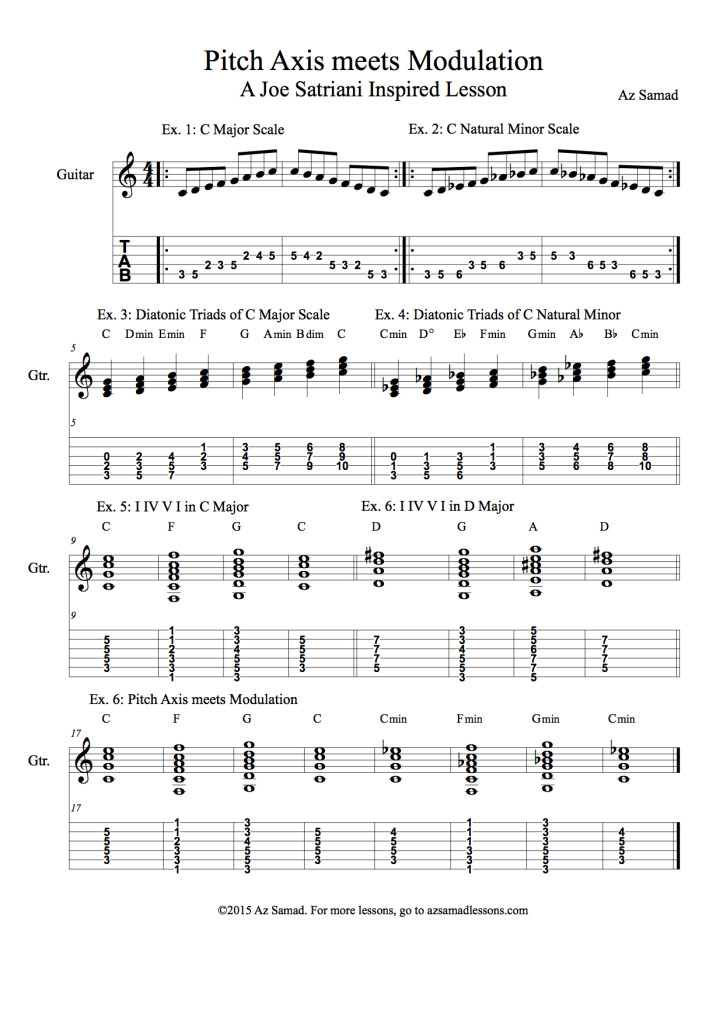This is a video response to a question that Ayang Daniel Johns asked me on Facebook.
Do you have a question about guitar playing? Please leave a comment below & I might cover it in a future post. =)
If you like the lesson, please sign up for my mailing list to get more lessons like this! =)
 [CLICK TO TWEET]
[CLICK TO TWEET]
Learn about Joe Satriani style pitch axis & modulation at azsamadlesssons.com
[NOTES]
Click here to download a PDF Version of the notes:
Pitch Axis Meets Modulation – A Joe Satriani Inspired Lesson
There are 6 steps covered in this video lesson:
1) How to build parallel major and minor scales
2) How to build diatonic chords
3) Creating a chord progression
4) Modulating normally
5) Pitch Axis
6) Pitch Axis-Modulating
Let’s look at it one by one:
1) How to build parallel major and minor scales
Firstly, let’s start with the C Major Scale:
C D E F G A B C
Then, we look at the C Natural Minor scale:
C D Eb F G Ab Bb C
These are 2 scales build on the same root.
2) How to build diatonic chords
These are the diatonic chords in the C Major Scale:
C Dmin Emin F G Amin Bdim C
I IImin IIImin IV V VImin VIIdim
Then, we build diatonic triads in the C Natural Minor scale:
Cmin Ddim Eb Fmin Gmin Ab Bb C
Imin IIdim bIII IVmin Vmin bVI bVII
3) Create a chord progression
Let’s say we take a simple chord progression:
C / / / | F / / / | G / / / | C / / / |
The analysis/formula would be:
I / / / | IV / / / | V / / / | I / / / |
4) Modulating normally
When we take it by the roman numeral and build a similar one in another key, you may get this:
C / / / | F / / / | G / / / | C / / / |
D / / / | G / / / | A / / / | D / / / |
This is a direct modulation, the first 4 bars are in C Major & the next 4 bars are in the key of D Major.
The analysis/formula would be:
C: I / / / | IV / / / | V / / / | I / / / |
D: I / / / | IV / / / | V / / / | I / / / |
This is the kind of modulation (change of key) that happens in pop/rock/classical.
5) Pitch Axis
Pitch Axis is a concept that I first heard Satriani mention in his interviews/lessons/articles.
The basic idea is to take a chord:
C
that uses the scale C Lydian
and let’s say we play it for 8 bars:
C / / / | / / / / | / / / / | / / / / |
/ / / / | / / / / | / / / / | / / / / |
Then, we change it to Cmin7
C / / / | / / / / | / / / / | / / / / |
/ / / / | / / / / | / / / / | / / / / |
Cmin7 / / | / / / / | / / / / | / / / / |
/ / / / | / / / / | / / / / | / / / / |
This gives a kind of a mood/vibe/atmosphere/emotion that is common in Satriani’s music. He uses this A LOT!
6) Pitch Axis-Modulating (this is the concept that Joe Satriani introduces in his book)
If we take the original progression:
C / / / | F / / / | G / / / | C / / / |
which was in C Major:
C Dmin Emin F G Amin Bdim C
I IImin IIImin IV V VImin VIIdim
with this formula:
C: I / / / | IV / / / | V / / / | I / / / |
and reduce it to the numbers but now write it as a minor key, i.e. C Natural Minor, we get this:
Cmin / / / | Fmin / / / | Gmin / / / | Cmin / / / |
because the same numbers, in a minor key would get these chords.
Cmin Ddim Eb Fmin Gmin Ab Bb C
Imin IIdim bIII IVmin Vmin bVI bVII
Then, if you combine them back to back, you get this new progression:
C / / / | F / / / | G / / / | C / / / |
Cmin / / / | Fmin / / / | Gmin / / / | Cmin / / / |
This gives a chance for you to create melodies build on a similar progression. It’s a chance to recycle and create music that is related to what you previously did.
[ACTION STEPS – HOW TO PRACTICE]
Thanks for checking out this blog post! Now, the question is:
“How do I practice all this?”
Here are some practice ideas for you to try depending on your goals:
GOAL 1:
If you’d like to really learn this Pitch Axis stuff inside out:
1) Practice writing out the different modes you’d like to explore in all 12 keys.
2) Start by picking the root, for example maybe F
3) Write out the scale for 2 different modes you’d like to explore. Maybe F Lydian and F Aeolian
F Lydian: F G A B C D E F
F Aeolian: F G Ab Bb C Db Eb F
4) Decide on a scale fingering you’d like to explore
5) Compose or improvise a melody in the first mode/scale. In this case, it would be F Lydian
6) Play the melody you composed but alter the notes to make it fit into F Aeolian
7) Record all this and listen to the results. Figure out what sounds good & what you’d like to explore more of
8) Repeat steps 1 to 7
GOAL 2:
If you’d like to explore this Pitch Axis meets Modulation stuff inside out:
1) Practice writing out the different modes you’d like to explore in all 12 keys.
2) Start by picking the root, for example maybe F
3) Write out the scale for 2 different modes you’d like to explore. Maybe F Lydian and F Aeolian
F Lydian: F G A B C D E F
F Aeolian: F G Ab Bb C Db Eb F
4) Decide on a scale fingering you’d like to explore
5) Write out the diatonic triads for both modes
6) Create a simple 4 bar chord progression using some of the diatonic triads in the first mode
7) Write another 4 bars by altering the notes of the original mode to the new mode
8) Compose or improvise a melody in the first mode/scale, in this case F Lydian
9) Play the melody you composed but alter the notes to make it fit into F Aeolian
10) Record all this and listen to the results. Figure out what sounds good & what you’d like to explore more of
11) Repeat steps 1 to 10

I’d also like to note that what people call “Pitch Axis Theory” is not exactly something that Joe Satriani invented.
Good article, thx!
I always try to explain Pitch Axis in a “as simple as possible” way for beginners, like:
– Take a random root note, let’s say: A
– Define which chords would define a certain mode:
.. for A-Phrygian: Am Bb/A (resulting in intervals 1 b2 b3 4 5 b6 (we missed b7)
.. for A-Lydian: A B/A (resulting in intervals 1 2 3 #4 5 6 (we missed 7)
Our “missed” b7 and 7 can be ignored, as the lydian and phrygian scales (in the given context) would be heard automatically (for the most of us)).
Then we play (for a while) the above written chords, let’s say for 16 bars – and we’re happy to improvise over them:
||: A | B/A :|| x16 (A-Phrygian)
||: Am | Bb/A :|| x16 (A-Phrygian)